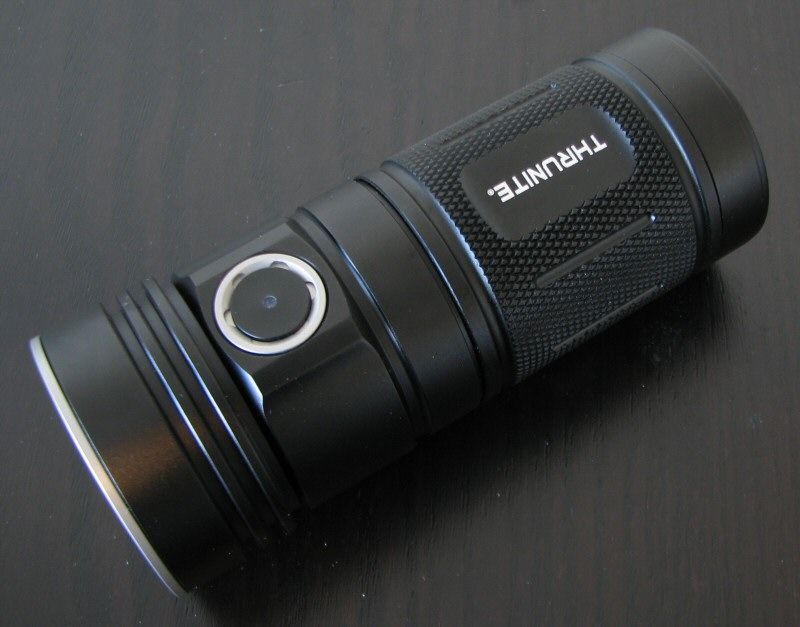
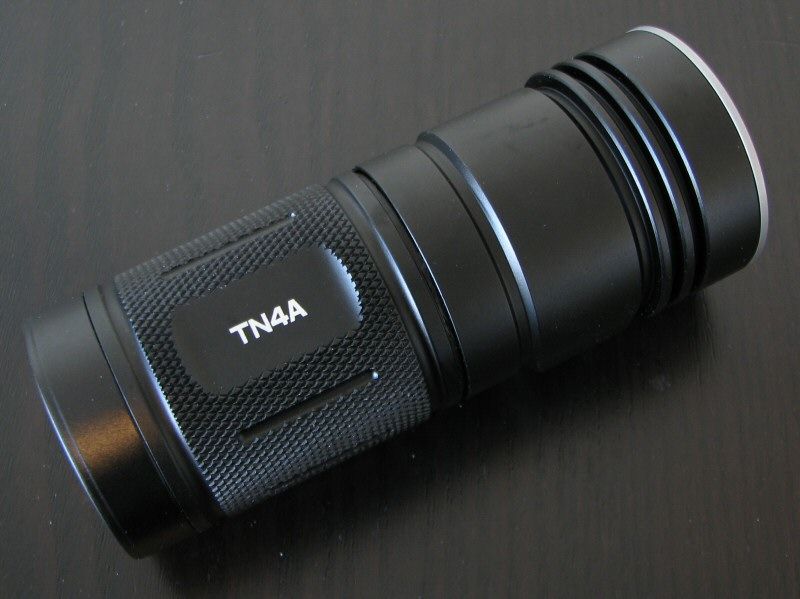
The TN4A is Thrunite's first entry into the popular world of compact 4xAA flashlights. As you'll see in the specs below, it also tops the output charts for this class - thanks to use of the new XP-L emitter.
How does the TN4A compare to the all other members I've tested in this class? I will do my usual detailed testing on this model below. But please also check out my 4xAA Round-up Review, to see additional comparisons to other members of this class.
Let's get started …
Manufacturer/Dealer Reported Specifications:
(note: as always, these are simply what the dealer/manufacturer provides – scroll down to see my actual testing results).
- LED: CREE XP-L V6
- Runs on: 4x AA(NIMH 2450MAH)
- Working Voltage: 2.75-8V
- Output mode/Runtime*: Strobe(1150 lumens/150 minutes), Turbo(1150 lumens /56 minutes), High(550 lumens / 150 minutes), Medium(139 lumens / 14 hrs), Low(15 lumens / 93 hrs), Moonlight(0.5lumens/80 days).
- Peak Beam Intensity: 26640cd
- Max beam distance: 326m
- Compact thrower with high quality beam from orange peel reflector.
- Latest LED technology gives great light efficiency.
- Advanced electronic switch with low voltage indication for silent operation.
- ThruNite ITC (intelligent temperature control) technology to prevent possible light damage from overheating.
- Six modes: firefly, low, medium, high, turbo and strobe.
- Reversed polarity protection system prevents damage to the light.
- Ultra clear tempered glass lens with anti-reflective coating.
- Aircraft grade aluminum body structure with knurling for firm grip.
- Premium type III hard anodized anti-abrasive finish.
- Memory function to set any mode(except for firefly, turbo and strobe) for immediate use.
- Impact resistant: 2 meters.
- Waterproof to IPX-8 Standard (1.5meters)
- Weight: 218.6g without battery.
- Dimensions: 111.5mm in length, 45.5mm in diameter.
- Accessories: Holster x1 Spare O ring x2 Battery Carrier x1(inside the flashlight)
- MSRP: ~$55
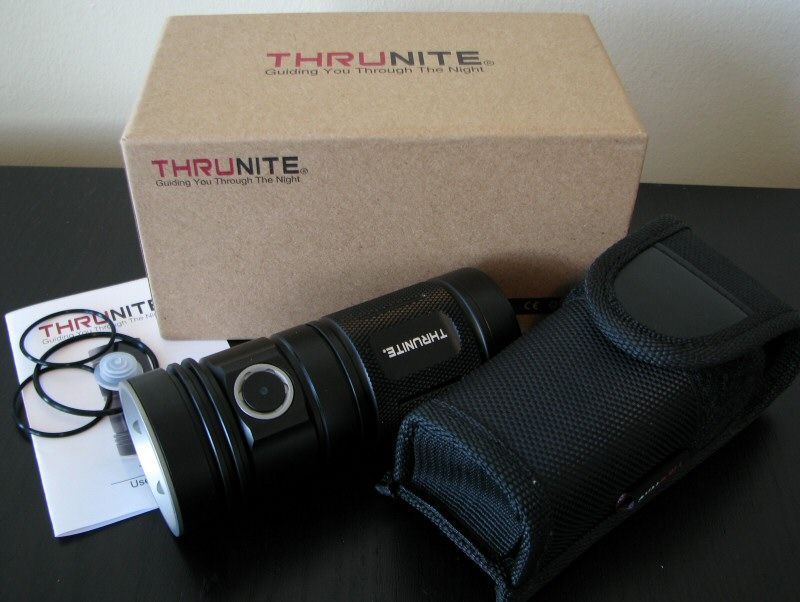
Packaging is the standard hard cardboard box with packing foam. Inside, included with the light are spare O-rings, holster with Velcro closing flap, spare switch cover, and manual. Note that there is no wrist-strap provided (nor an obvious place to attach one). I will discuss the purpose of the spare switch cover later in this review.
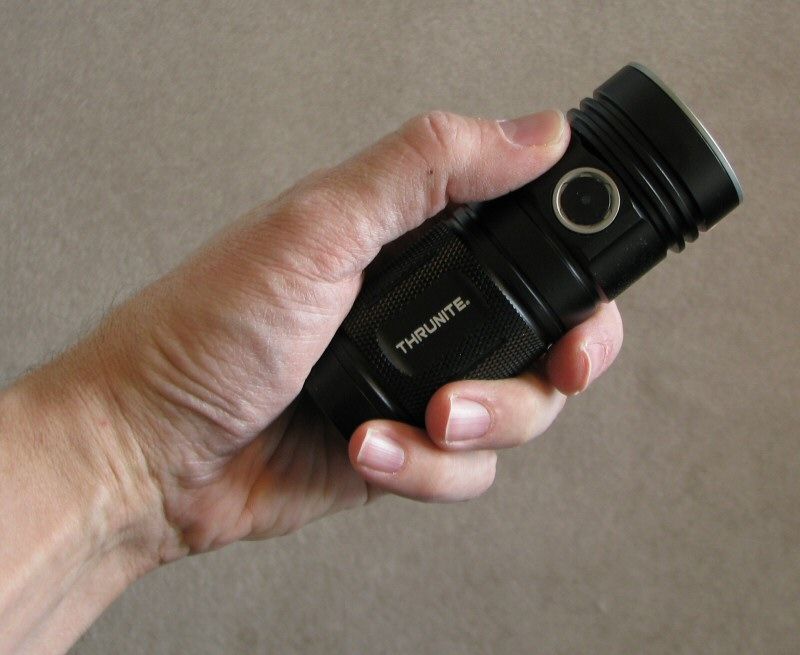
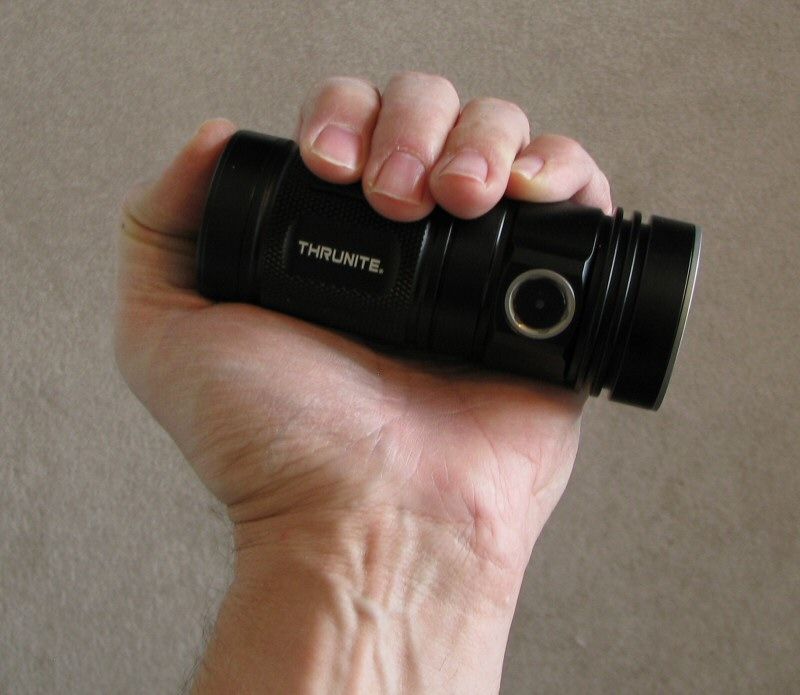
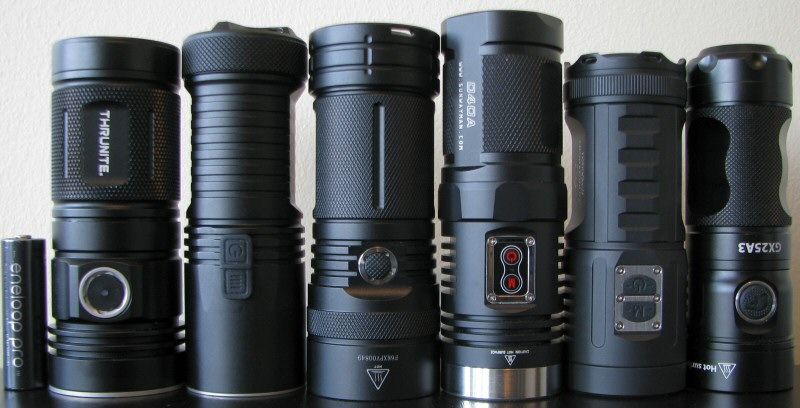
From left to right: Panasonic Eneloop Pro (2550mAh) NiMH; Thrunite TN4A; Nitecore EA41; Fenix E41; Sunwayman D40A, F40A; Eagletac GX25A3.
All dimensions directly measured, and given with no batteries installed (unless indicated):
Thrunite TN4A 4xAA: Weight: 217.6g, Length: 112.6mm, Width (bezel): 45.5mm, (tail): 42.0mm
Eagletac GX25A3 3xAA: Weight: 151.4g, Length: 109.2mm, Width (bezel): 38.6mm
Fenix E41 4xAA: Weight: 204.1g , Length: 115.9mm, Width (bezel): 44.1mm
JetBeam PA40 4xAA: Weight: 184.0g, Length: 183mm, Width: 40.8mm (bezel), 42.1mm (max width)
JetBeam SRA40 4xAA: Weight 236.0g, Length: 126.1mm, Width (bezel): 48.5mm
Lumintop SD10: Weight: 117.6g, Length: 120.3mm, Width (bezel): 40.1mm
Nitecore EA41 2015 4xAA: Weight: 147.9g , Length: 118.4mm, Width (bezel): 40.1mm
Nitecore EA4 4xAA: Weight: 161.6g , Length: 117.9mm, Width (bezel): 40.2mm
Sunwayman D40A 4xAA: Weight: 167.9g, Length: 120.4mm, Width (bezel): 40.0mm
Sunwayman F40A 4xAA: Weight: 182.0g, Length: 109.3mm, Width (bezel): 42.0mm
The TN4A is a little heavier than most lights of this size in the 4xAA class, but otherwise overall dimensions are comparable. Note that it is a bit wider at the head than the tail (i.e., flares out a little before the bezel).


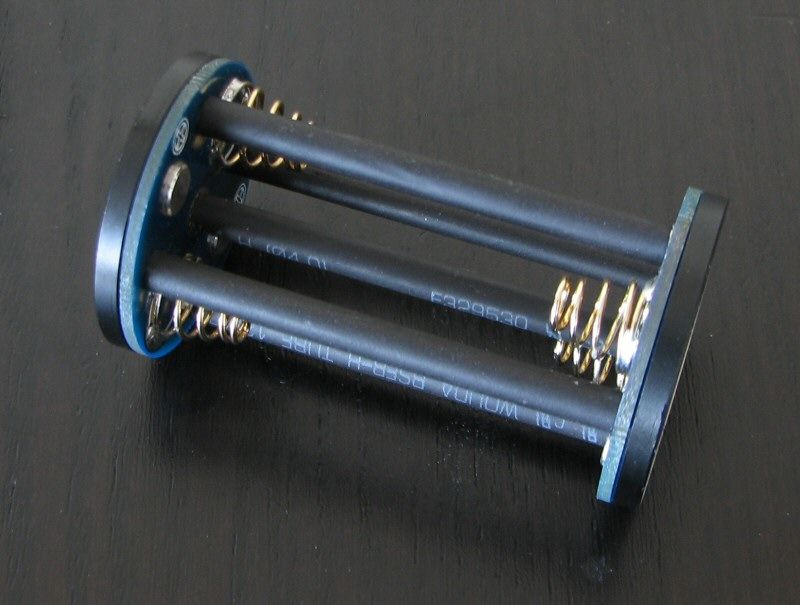
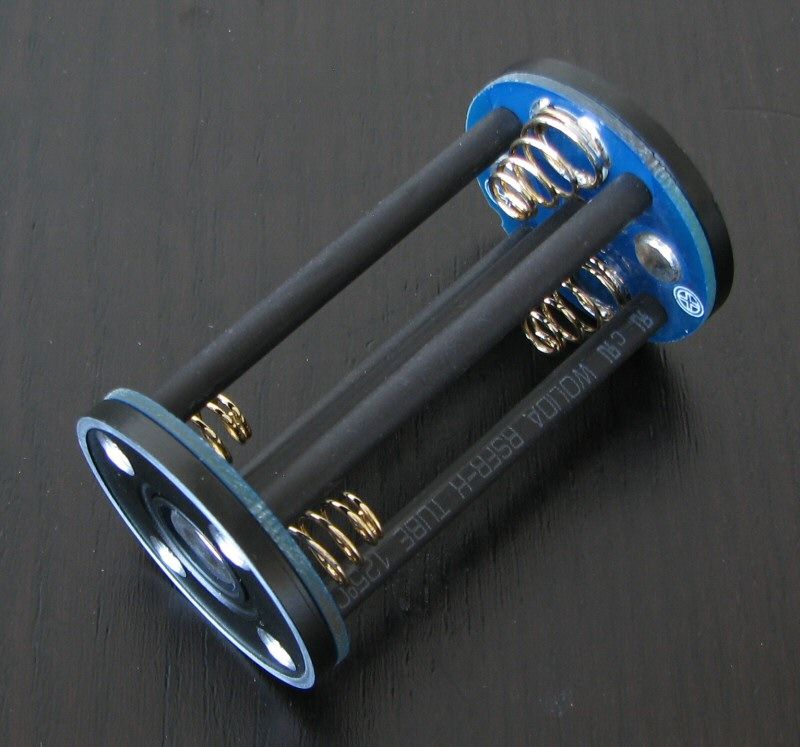
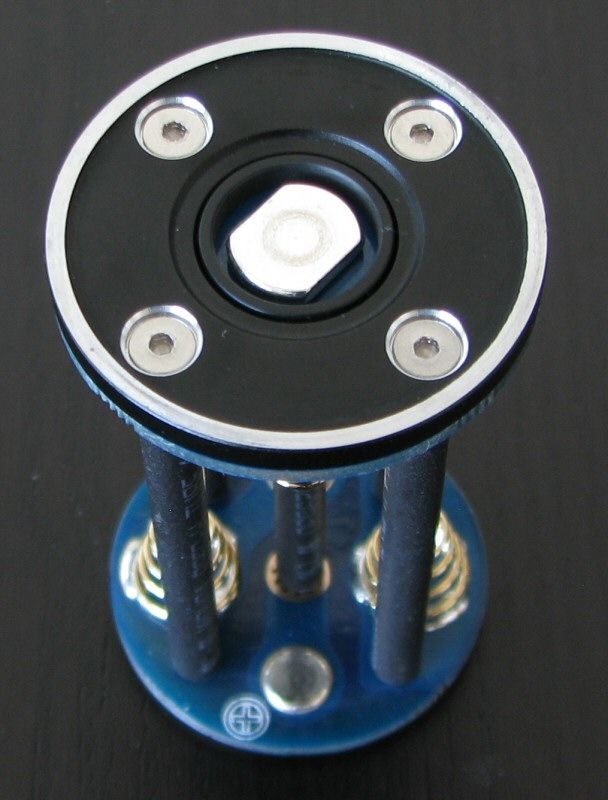
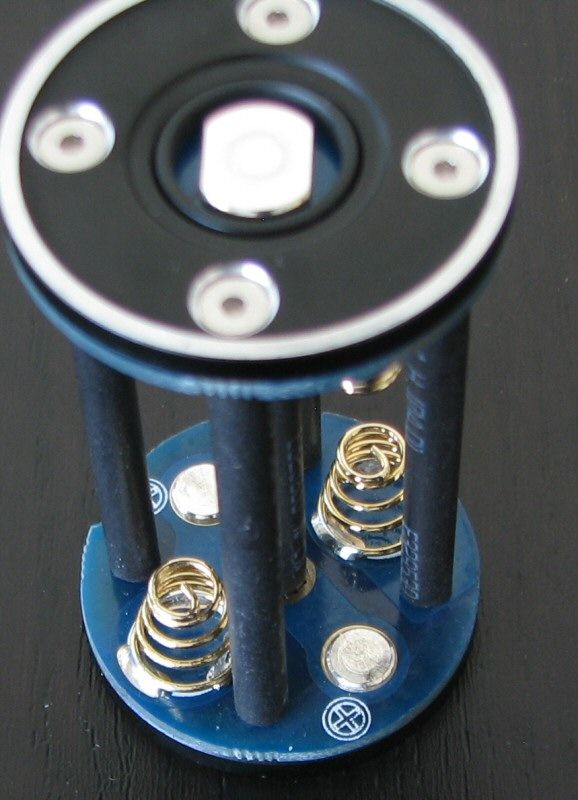
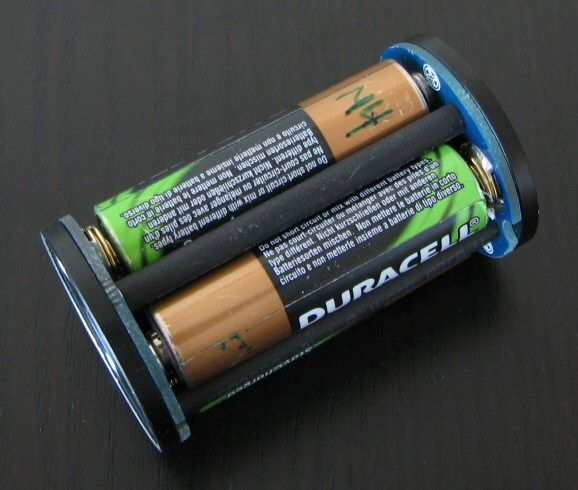

The TN4A is cylindrical, like most other members of this class. Anodizing is a flat black, and is in excellent shape on my sample. Body labels are minimal, and clear. Knurling on the body handle is slightly more aggressive than typical for this class, and helps with grip. Note the light can roll fairly easily, and there is no obvious attachment point for a wrist lanyard (none provided). The light can tailstand stably.
Screw threads are square-cut, and anodized for lock-out. A quick twist of the head is all that is required to lock out the light. :thumbsup:.
The TN4A uses a battery carrier to hold the 4xAA cells. The carrier is reversible inside the light. Although it seems well made, there is a lot of tension on the springs for each battery. I found it hard to insert and remove cells – especially my Panasonic Eneloop Pros, which were a real challenge to get out. I would recommend they use shorter springs in this carrier.
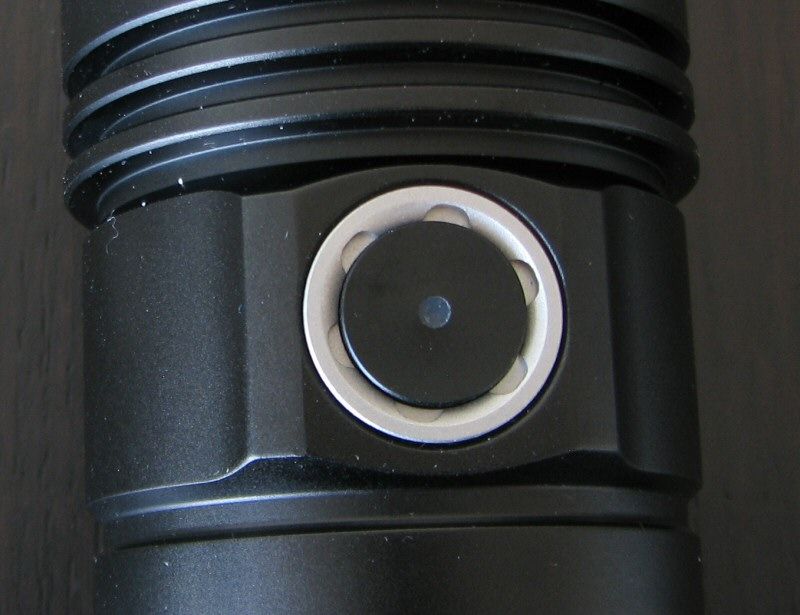
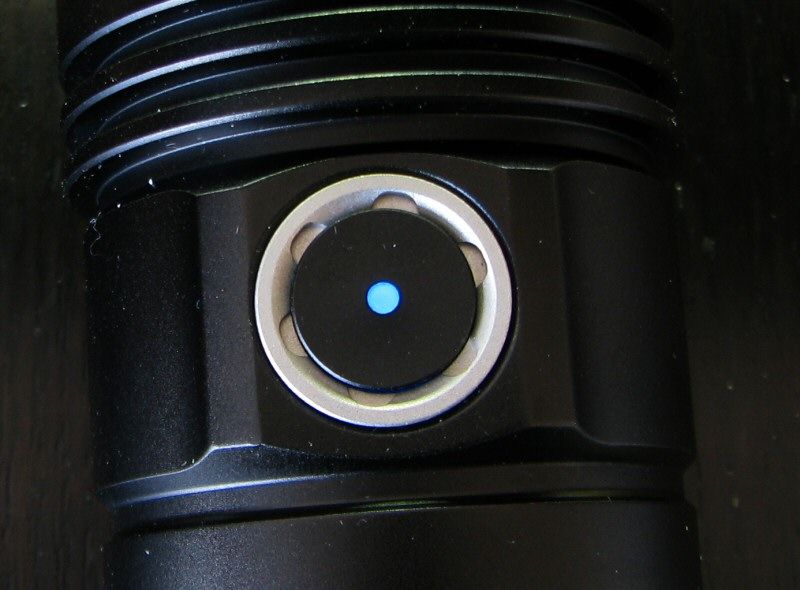
The TN4A uses a single electronic switch to control on/off and mode switching. Switch design is distinctive, as there is a hard plastic outer switch cover, with a clear centre (used to show blue LED indicator underneath). There is a stainless steel ring surrounding the switch, which holds the switch cover in place. Actual switch feel is about typical, and there is a definite "click" when making full contact. Scroll down for a discussion of the user interface.
But first, you may be wondering what the extra clear switch boot cover is for. Let me demonstrate by opening everything up. You start by unscrewing the stainless steel surround, using snap-ring pliers (or very firm tweezers).
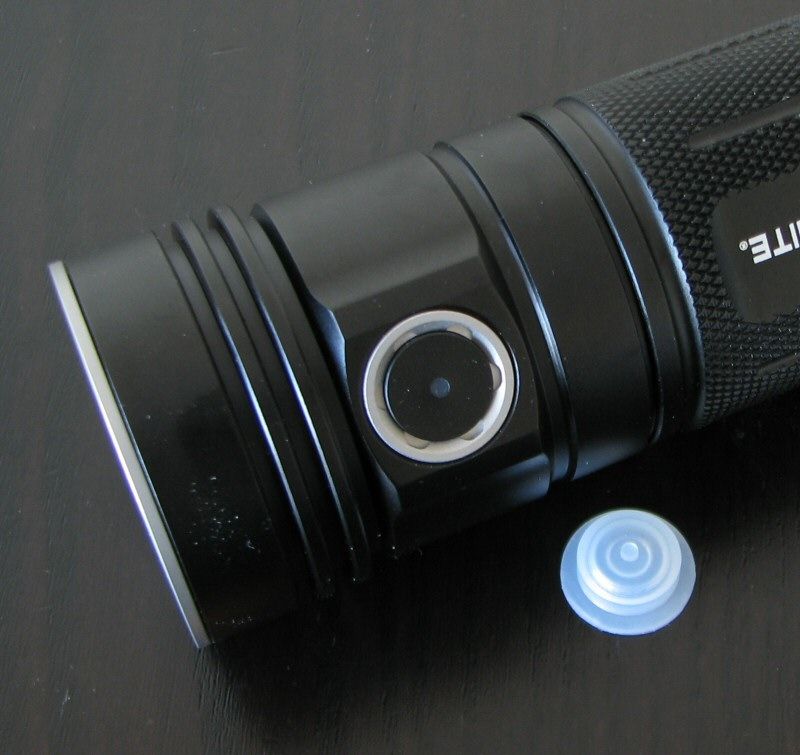
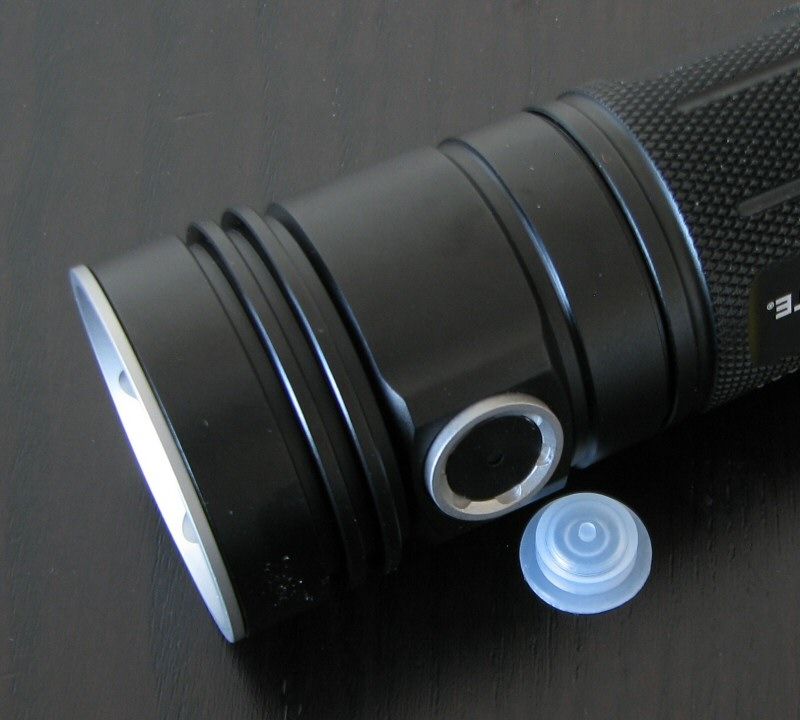
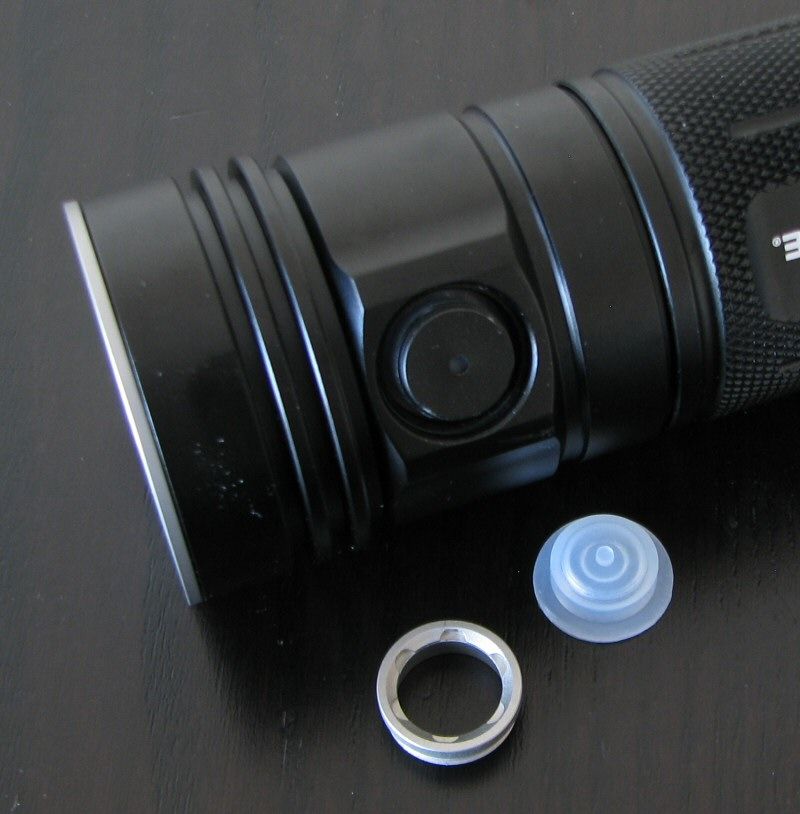
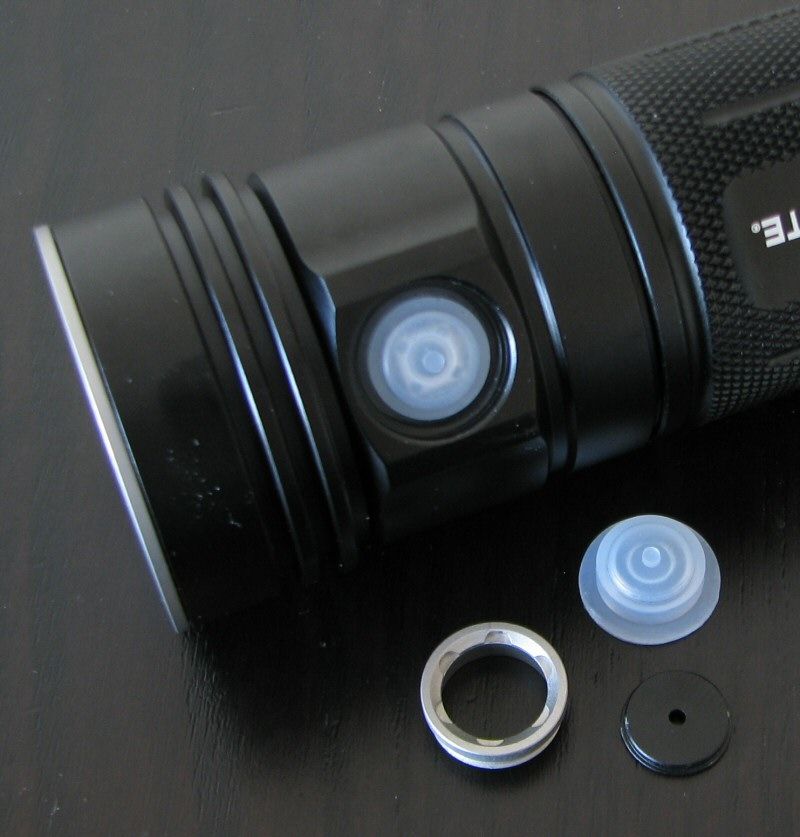
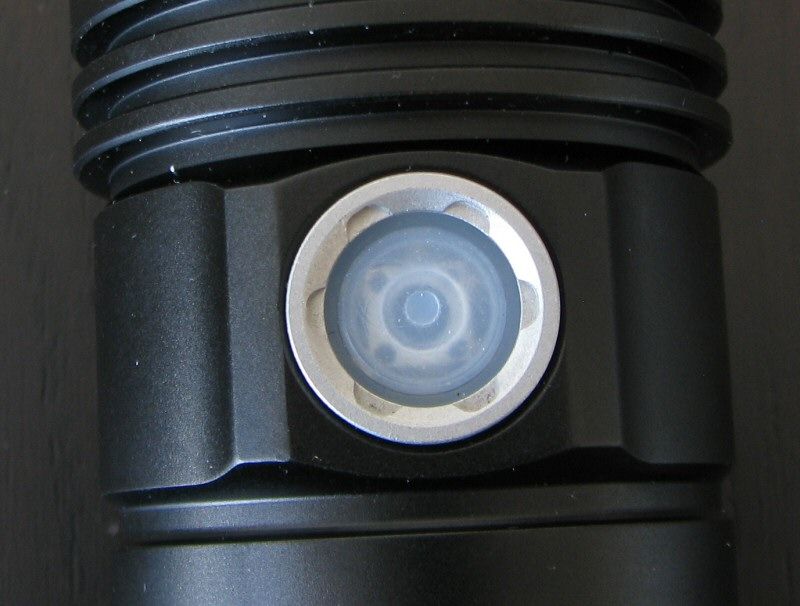
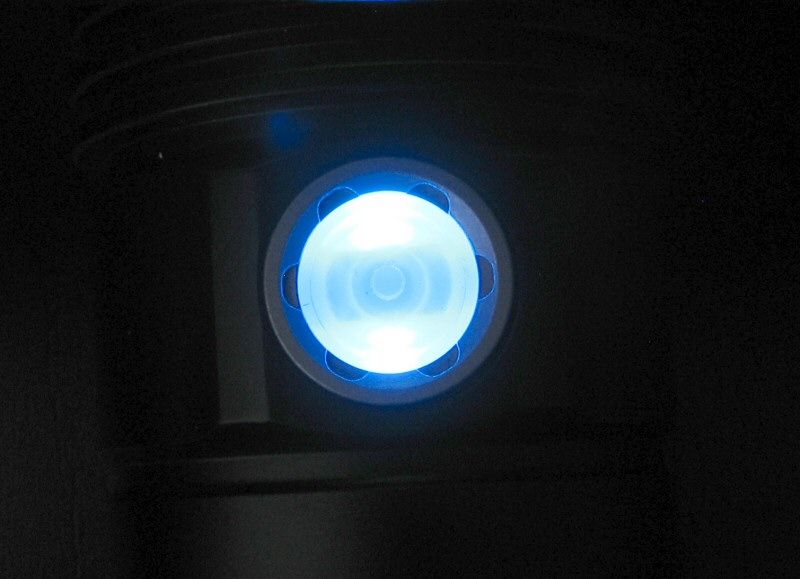
Basically, the extra clear switch cover is just a replacement for the built-in cover underneath the external button. The light is always meant to be run with the outer button cover in place.
The TN4A is distinctive for this class for its choice of the new XP-L emitter. Basically, the XP-L is an XM-L2-sized die that has been squeezed into a XP-G2 footprint. It is meant to be a drop-in replacement for XP-G2 (for more output but reduced throw), and should be comparable to the XM-L2 for output.
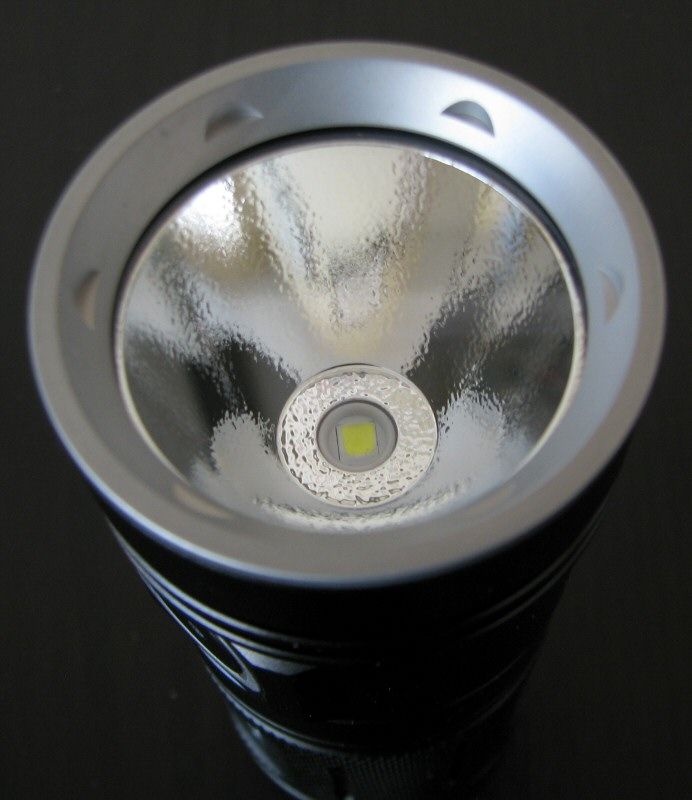
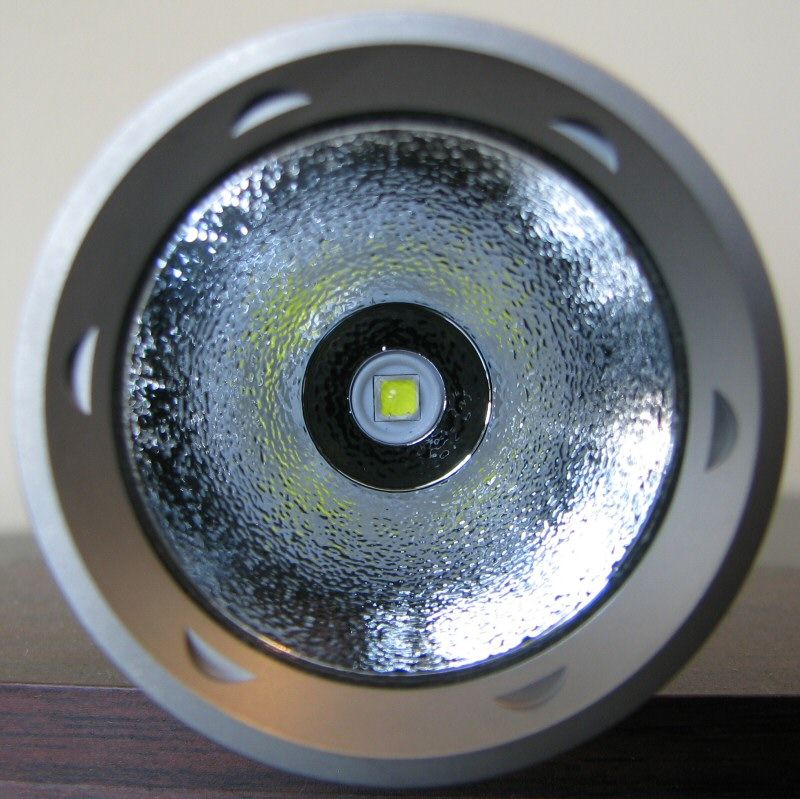
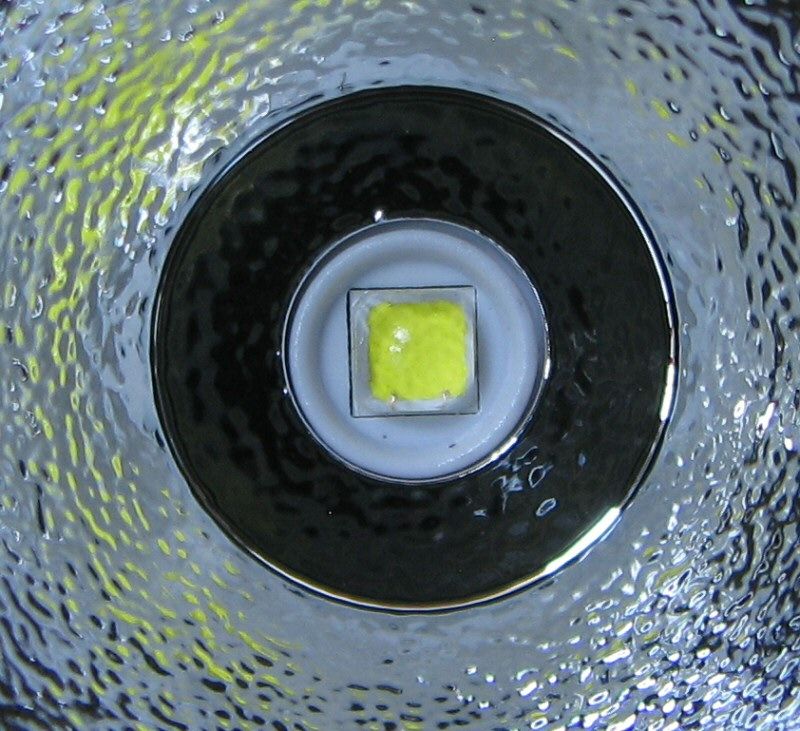
XP-L was perfectly centered on my sample, thanks to use of a centering disc. As you can see, the TN4A uses a textured reflector, which is not as deep as some in this class. Unfortunately, the reflections from the reflector texturing are distorting the emitter image above. Scroll down for beamshots and direct throw measures.
User Interface
The TN4A uses a single electronic switch for on/off and mode control. Turn the light on by a single click (rapid press-release).
From on, change output modes by holding the switch down. The light will cycle between constant output modes in the following order: Lo > Med > Hi, in repeating sequence. The light has mode memory, and will retain the last constant output used when turning off and back on.
To access Firefly, there is a shortcut accessible only from off: press-and-hold the switch.
To access Turbo, there is a shortcut from either on or off: double-click the switch. To access Strobe, double-click the switch again (i.e., need to be in Turbo mode). Double-click again exits to Turbo (single click turns off, as always).
There is no mode memory for the shortcut-required modes.
Video:
For more information on the overall build and user interface, please see my new video overview:
As with all my videos, I recommend you have annotations turned on. I commonly update the commentary with additional information or clarifications before publicly releasing the video.
As an aside, if you want to get an instant notification for every new review that I post here on CPF, you can subscribe to my YouTube channel (the vids go public at the same time). Just mouse over my logo watermark on the top right-hand corner of the video for the subscribe feature to open up. You may need to tap or click, depending on the platform you are using to watch. :wave:
PWM/Strobe
There is no sign of PWM that I can see, at any output level – the TN4A is fully current-controlled.
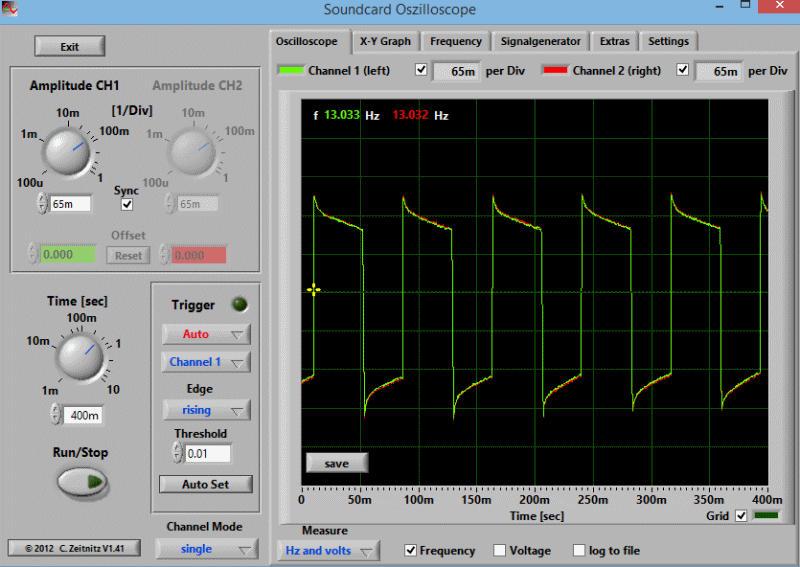
Strobe was a fairly fast tactical strobe of 13 Hz.
Standby Drain
A standby current drain is inevitable on the TN4A, due to the electronic switch in the head. I have measured this current as 6.5uA on my sample. Given the batteries are in series in the carrier, that would mean that a 2000mAh Eneloop NiMH would be fully drained in about 35 years (theoretically).
Note that you can easily break this current by unscrewing the head slightly, thanks to the anodized threads and use of a battery carrier. I recommend you do for this for lowering the risk of accidental activation – it certainly is not necessary from a current drain perspective.
Beamshots:
And now the white-wall beamshots.
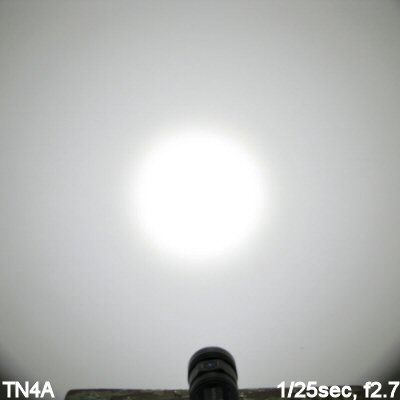
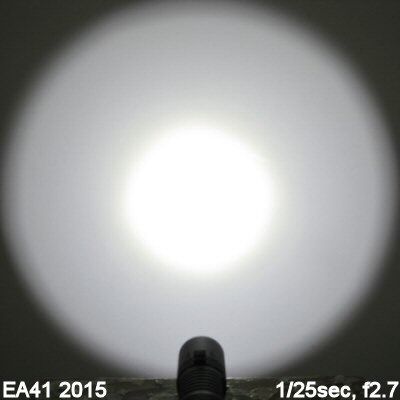
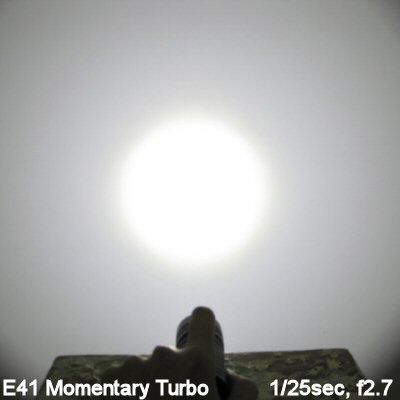
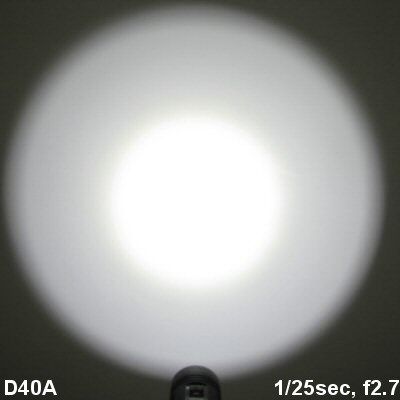
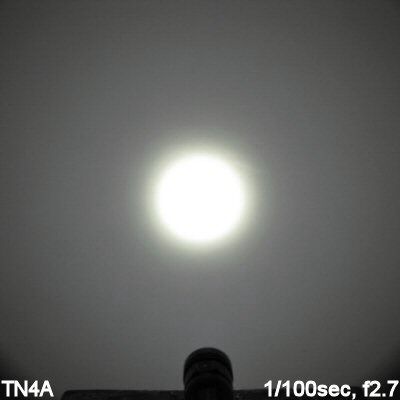
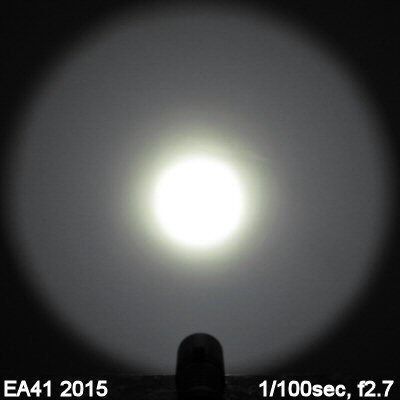
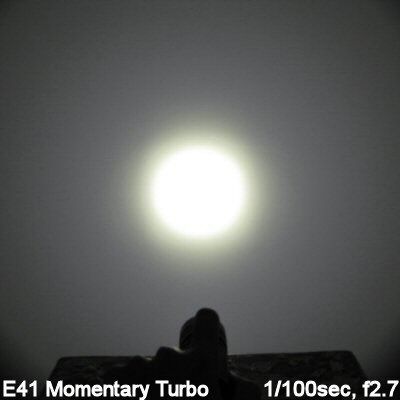
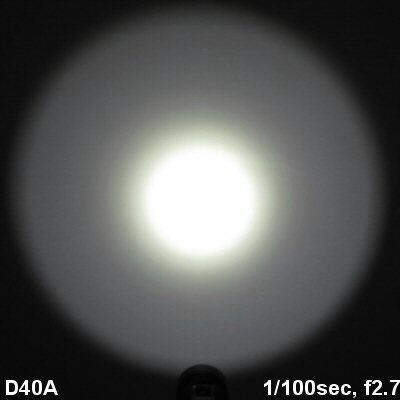
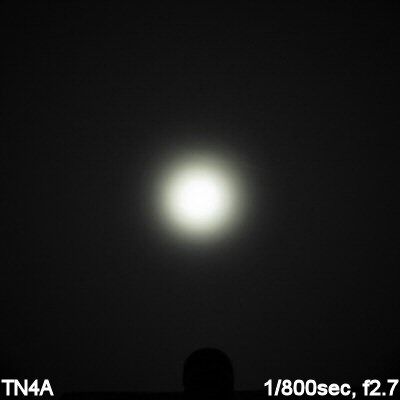
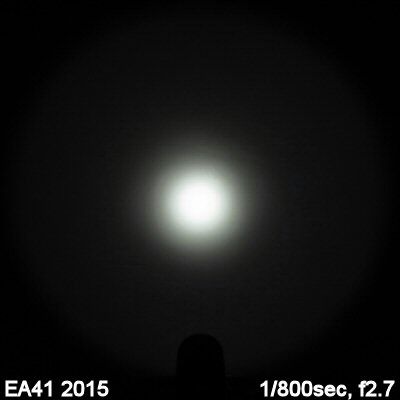
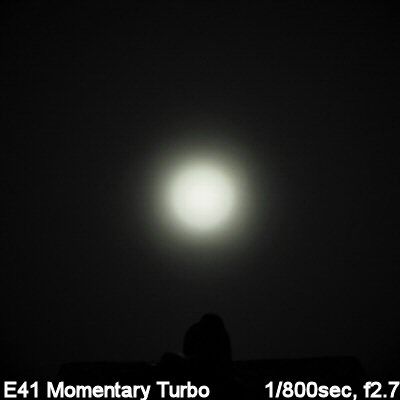
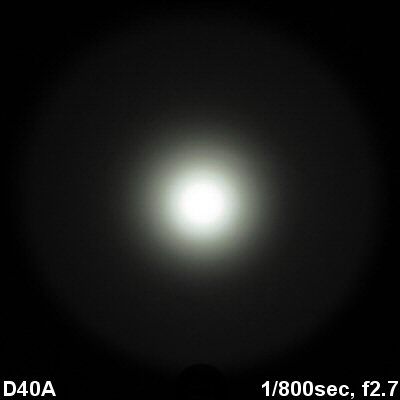
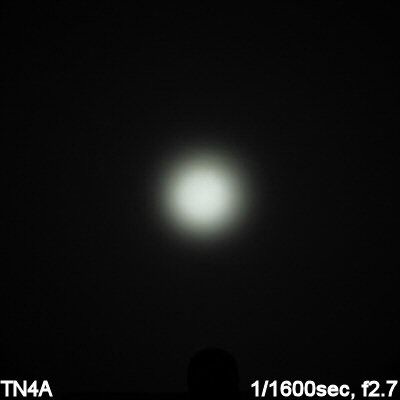
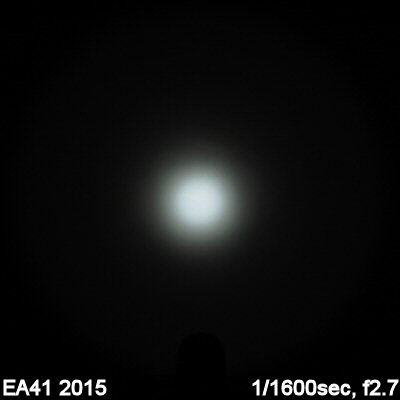
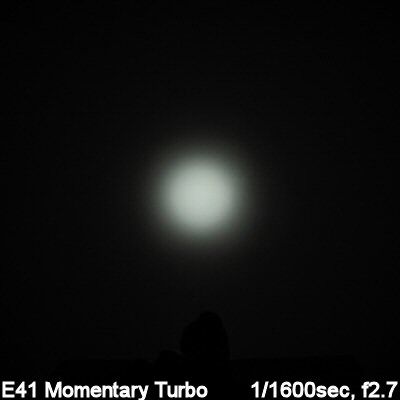
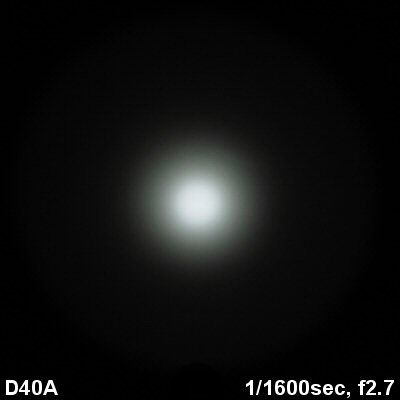
Thanks to shallower than typical reflector, the TN4A has a much "floodier" beam profile – very similar to the Fenix E41 (i.e., a very wide spillbeam). Throw is still significant on the TN4A – scroll down for some direct measures.
There is some tint variation in the beam profile of my sample, with a somewhat yellow-green tint-shift in the corona specifically. I don't know whether that is due to the reflector design or the XP-L emitter (or some combination thereof). Not an issue for me personally, but fans of consistent beam tint may object.
Testing Method:
All my output numbers are relative for my home-made light box setup, as described on my flashlightreviews.ca website. You can directly compare all my relative output values from different reviews - i.e. an output value of "10" in one graph is the same as "10" in another. All runtimes are done under a cooling fan, except for any extended run Lo/Min modes (i.e. >12 hours) which are done without cooling.
I have devised a method for converting my lightbox relative output values (ROV) to estimated Lumens. See my How to convert Selfbuilt's Lightbox values to Lumens thread for more info.
Throw/Output Summary Chart:
My summary tables are reported in a manner consistent with the ANSI FL-1 standard for flashlight testing. Please see http://www.flashlightreviews.ca/FL1.htm for a discussion, and a description of all the terms used in these tables. Effective July 2012, I have updated all my Peak Intensity/Beam Distance measures with a NIST-certified Extech EA31 lightmeter (orange highlights).
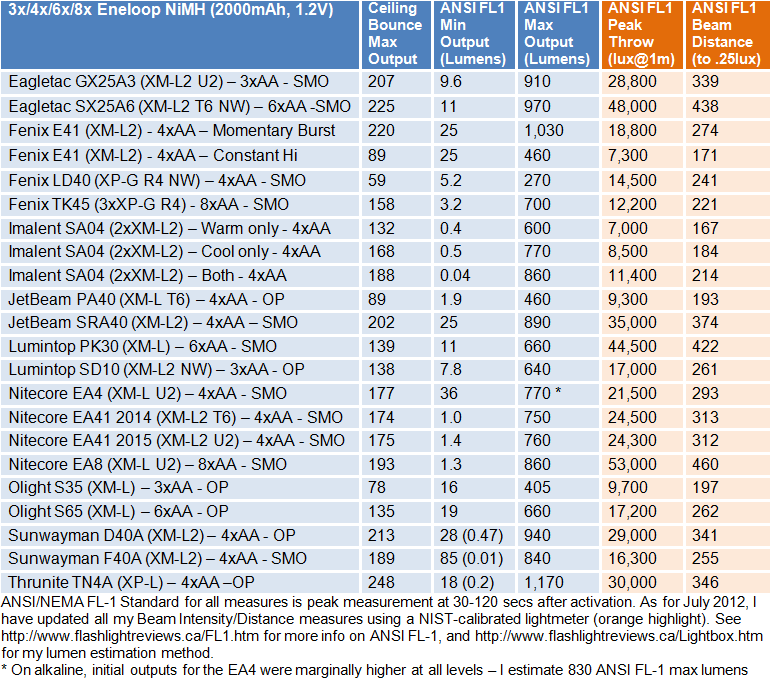
Overall output of the TN4A on Turbo exceeds any of my other 4xAA lights at present.
Let's see how output compares across the various levels:
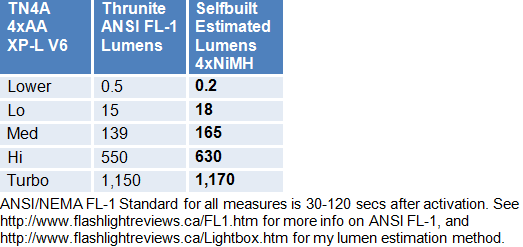
I typically get very good concordance of my output measures with Thrunite's published specs, and the TN4A is no exception.
Output/Runtime Graphs:
Note that I have been moving my NiMH AA testing to the newer Panasonic Eneloop Pro NiMH (2550mAh typical capacity). Panasonic acquired Sanyo a little while back, and the new Panasonic-branded Eneloop Pro cells are an updated version of the former Eneloop XX cells (i.e., Panasonic Pros are basically 3rd generation XX cells, with improved charge holding ability). These were a very tight fit in the TN4A, but I was able to perform my full range of battery testing here.
Also, keep in mind that all my runtime tests are done under a cooling fan.
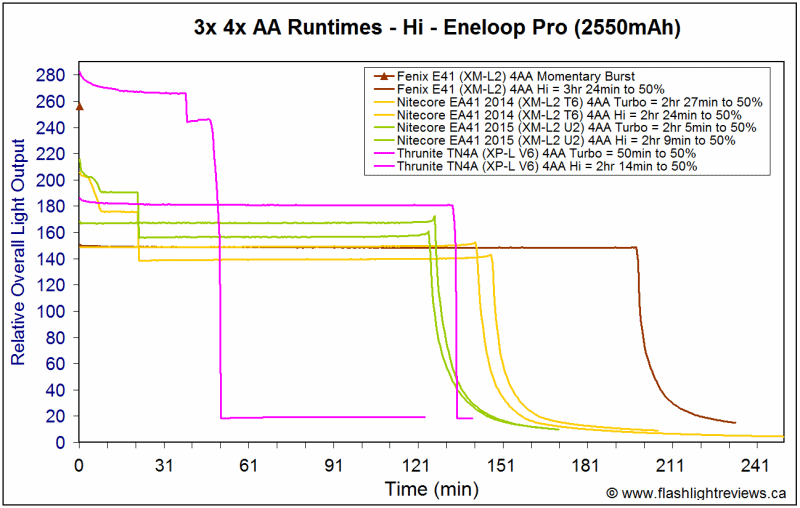
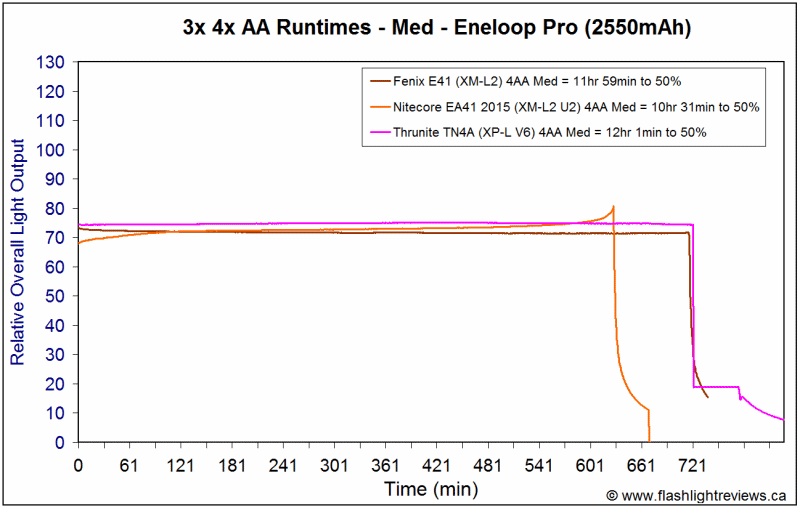
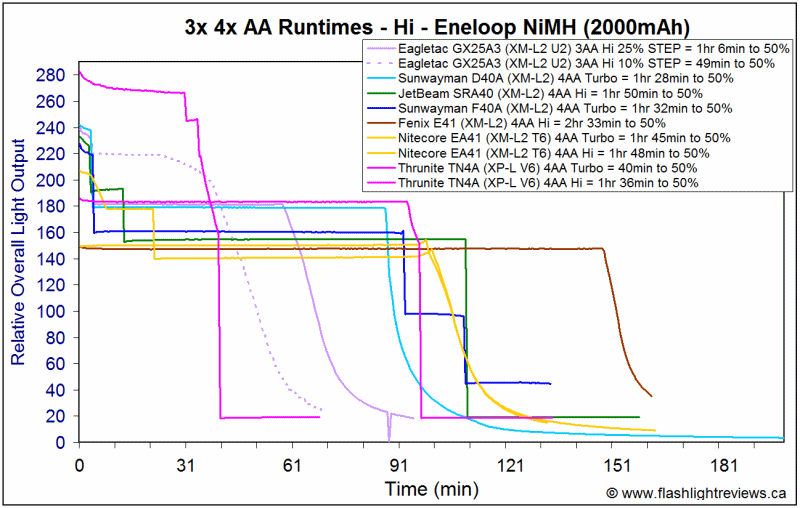
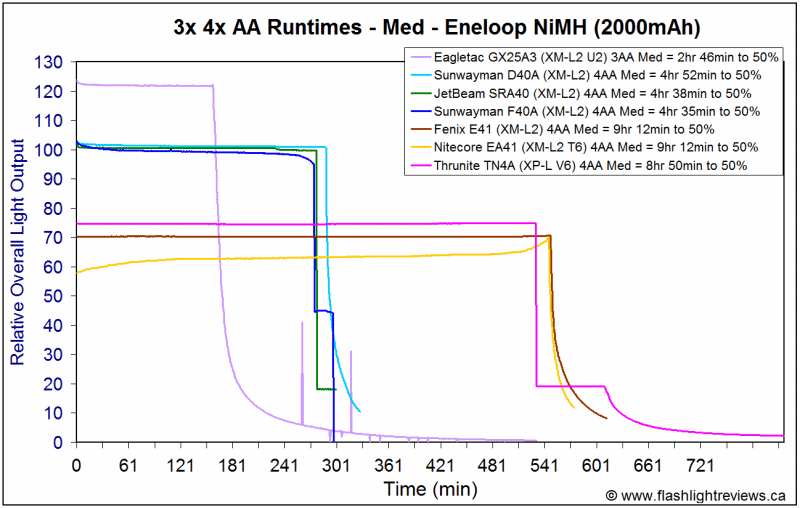
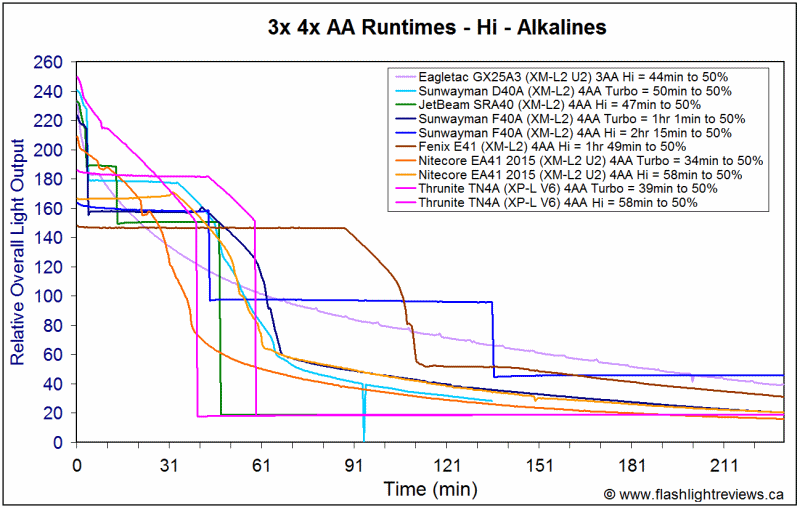
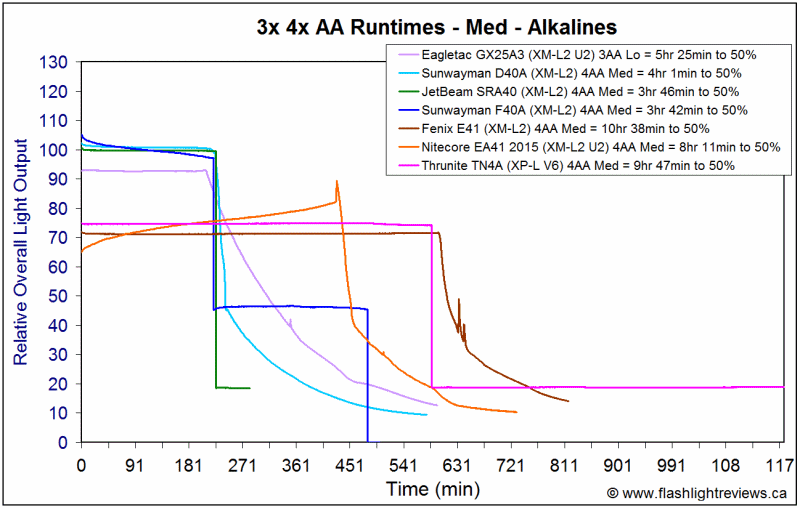
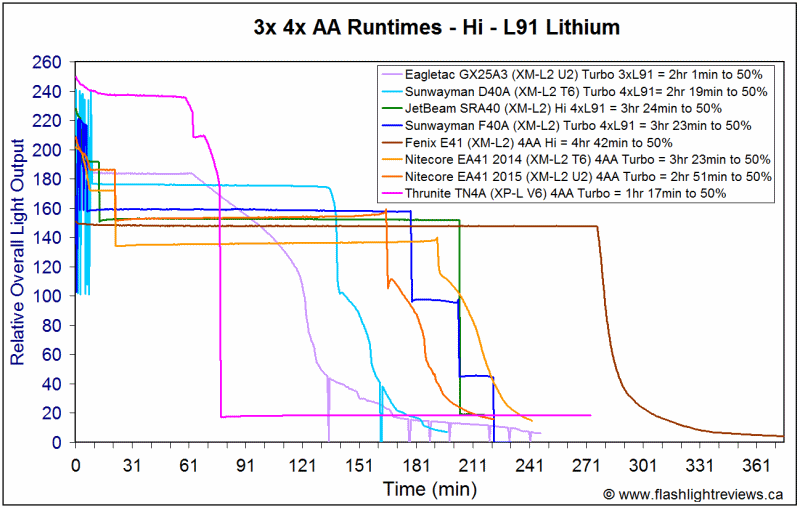
On Med/Hi levels, the TN4A is certainly a very efficient performer - consistent with the Fenix E41 or Nitecore EA41 2015. :thumbsup: It also shows a very flat-stabilized regulation pattern.
But where the TN4A really "shines" (pardon the pun) is on its Turbo level. This is frankly an unbelievable amount of light – even higher than the momentary Turbo mode of the Fenix E41. I am also impressed that the step-down only occurred near the end of the regulated initial run, as the batteries were nearing exhaustion (i.e., ~30 mins on Eneloop, ~40mins on Eneloop Pro, and ~60 mins on L91 lithium). Of course, alkalines are not a good source cell for sustained Turbo output – I recommend you stick with the Hi mode on those AA cells.
Basically, you get top-of-the-line output/runtime efficiency at all levels, and by far the highest maximum regulated constant output of any 4xAA light that I've tested. :wave:
Potential Issues
The light does get very hot with sustained runtime on Turbo. Without externally supplied cooling, I expect you would have drop down to a lower level fairly quickly (for personal comfort).
The battery carrier holds the AA cells very tightly, making it hard to get them in or out. It is particularly difficult with the longer Eneloop Pro cells – these are a very tight squeeze.
There is some variation in tint across the beam profile, with a detectable shift to yellow-green in the corona around the hotspot. This is likely due to some interaction between the XP-L emitter and this specific reflector design.
There is no obvious attachment point for a wrist strap/lanyard.
Due to the electronic switch in the head, the light has a stand-by current when batteries are installed. But this is completely negligible, and not a concern. To prevent accidental activation though, I recommend you lock the light out by a simple twist of the head.
Preliminary Observations
The TN4A is the highest output 4xAA light I've tested to date.
I don't know how Thrunite managed to drive this light so much harder than the competition, but they certainly didn't do it as the expense of efficiency – the TN4A is one of the best-regulated and most efficiency 4xAA lights I've tested. :thumbsup: It is also quite compact, consistent with the class (although a touch heavier, suggesting use of additional necessary heatsinking).
Right there, I expect a lot of readers are sold on the light. So are there any drawbacks? Well, the interface is certainly reasonable for a single-switch design – but I'm a fan of dual-switch lights for their greater versatility and intuitiveness. The battery carrier seems of quality design, but is awfully tight for modern high-capacity NiMH cells (i.e., my Eneloop Pros are very hard to get in or out of the carrier). I would recommend they relax the tolerances somewhat there.
In terms of beam profile, the TN4A has one of the widest spillbeams I've seen in this class while maintaining excellent throw (thanks to the super-high output). Fans of the Fenix E41 will also like the TN4A, I expect. For tint purists, please note that there was some noticeable yellow-green tint shifting in the corona surrounding the hotspot on my sample. I expect this is the result of an interaction of the new XP-L emitter with the heavily textured reflector design on this light.
I don't usually comment on price, but this is another area where the TN4A is very competitive for this class.
At the end of the day, the TN4A marks an excellent entry into the 4xAA realm by Thrunite. I expect max-lumen hounds will flock to this light, given the high Turbo drive level – but it is really a very good performer at all output levels. I plan to add these testing results to my 4xAA round-up soon, so you can compare it directly to all the members in this class. Certainly a strong contender.
----
TN4A was supplied by Thrunite for review.
Last edited:


